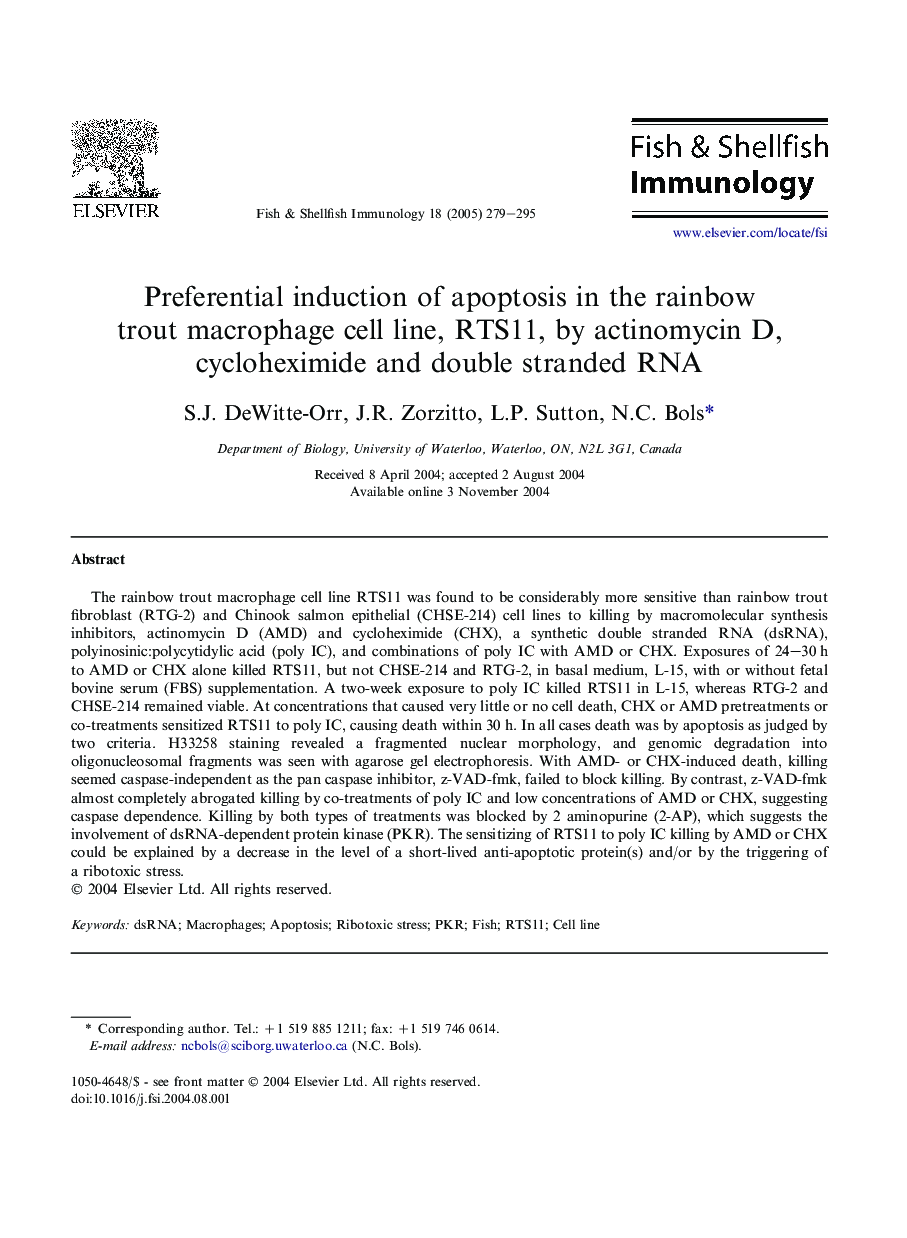| کد مقاله | کد نشریه | سال انتشار | مقاله انگلیسی | نسخه تمام متن |
|---|---|---|---|---|
| 8978723 | 1106867 | 2005 | 17 صفحه PDF | دانلود رایگان |
عنوان انگلیسی مقاله ISI
Preferential induction of apoptosis in the rainbow trout macrophage cell line, RTS11, by actinomycin D, cycloheximide and double stranded RNA
دانلود مقاله + سفارش ترجمه
دانلود مقاله ISI انگلیسی
رایگان برای ایرانیان
کلمات کلیدی
موضوعات مرتبط
علوم زیستی و بیوفناوری
علوم کشاورزی و بیولوژیک
علوم آبزیان
پیش نمایش صفحه اول مقاله

چکیده انگلیسی
The rainbow trout macrophage cell line RTS11 was found to be considerably more sensitive than rainbow trout fibroblast (RTG-2) and Chinook salmon epithelial (CHSE-214) cell lines to killing by macromolecular synthesis inhibitors, actinomycin D (AMD) and cycloheximide (CHX), a synthetic double stranded RNA (dsRNA), polyinosinic:polycytidylic acid (poly IC), and combinations of poly IC with AMD or CHX. Exposures of 24-30Â h to AMD or CHX alone killed RTS11, but not CHSE-214 and RTG-2, in basal medium, L-15, with or without fetal bovine serum (FBS) supplementation. A two-week exposure to poly IC killed RTS11 in L-15, whereas RTG-2 and CHSE-214 remained viable. At concentrations that caused very little or no cell death, CHX or AMD pretreatments or co-treatments sensitized RTS11 to poly IC, causing death within 30Â h. In all cases death was by apoptosis as judged by two criteria. H33258 staining revealed a fragmented nuclear morphology, and genomic degradation into oligonucleosomal fragments was seen with agarose gel electrophoresis. With AMD- or CHX-induced death, killing seemed caspase-independent as the pan caspase inhibitor, z-VAD-fmk, failed to block killing. By contrast, z-VAD-fmk almost completely abrogated killing by co-treatments of poly IC and low concentrations of AMD or CHX, suggesting caspase dependence. Killing by both types of treatments was blocked by 2 aminopurine (2-AP), which suggests the involvement of dsRNA-dependent protein kinase (PKR). The sensitizing of RTS11 to poly IC killing by AMD or CHX could be explained by a decrease in the level of a short-lived anti-apoptotic protein(s) and/or by the triggering of a ribotoxic stress.
ناشر
Database: Elsevier - ScienceDirect (ساینس دایرکت)
Journal: Fish & Shellfish Immunology - Volume 18, Issue 4, April 2005, Pages 279-295
Journal: Fish & Shellfish Immunology - Volume 18, Issue 4, April 2005, Pages 279-295
نویسندگان
S.J. DeWitte-Orr, J.R. Zorzitto, L.P. Sutton, N.C. Bols,